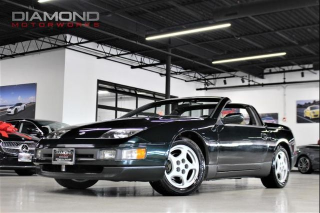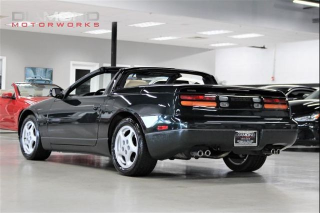The Good
The 1994 Nissan 300ZX boasts a stunning, enduring design and exhilarating performance, particularly the 300 hp Twin Turbo. Its precise handling and comfortable cabin (for a sports car) appeal to emotional drivers. Practical buyers appreciate its generally robust mechanicals when well-maintained, offering good long-term value as a modern classic, though efficiency is moderate.
The Bad
Known weaknesses include a notoriously cramped and complex engine bay, especially on Twin Turbo models, making maintenance labor-intensive and expensive. Watch out for aging electronics, brittle interior plastics, and potential heat-related issues. Neglected maintenance, particularly timing belt service, can lead to costly failures, so thorough inspection is crucial.
1994 Nissan 300ZX: Quick Overview
- Engine Options: The 1994 Nissan 300ZX offered two primary engine choices:
- VG30DE: A 3.0-liter DOHC 24-valve V6, naturally aspirated.
- VG30DETT: A 3.0-liter DOHC 24-valve V6 with twin sequential turbochargers and dual intercoolers.
- Horsepower:
- Naturally Aspirated (NA): 222 horsepower at 6400 RPM and 198 lb-ft of torque at 4800 RPM.
- Twin Turbo (TT): 300 horsepower at 6400 RPM and 283 lb-ft of torque at 3600 RPM.
- Fuel Economy (EPA Estimates):
- NA Manual: Approximately 18 MPG city / 24 MPG highway / 20 MPG combined.
- NA Automatic: Approximately 17 MPG city / 23 MPG highway / 19 MPG combined.
- TT Manual: Approximately 17 MPG city / 22 MPG highway / 19 MPG combined.
- TT Automatic: Approximately 16 MPG city / 21 MPG highway / 18 MPG combined. All models require premium unleaded fuel.
- 0-60 MPH Times:
- NA: Roughly 6.5 - 7.0 seconds.
- TT: Roughly 5.0 - 5.5 seconds, making it very competitive for its era.
- Towing Capacity: The Nissan 300ZX was not rated or recommended for towing. Its design prioritizes performance and handling, not utility.
- Trim-Level Features:
- Naturally Aspirated (NA): Standard features included power windows, power door locks, power mirrors, cruise control, automatic climate control, a basic audio system, and 16-inch alloy wheels. T-top roof was a common option. Available as a 2-seater or 2+2 (longer wheelbase with small rear seats).
- Twin Turbo (TT): Built upon the NA's features, adding significant performance and luxury. Standard TT features included leather upholstery, a premium Bose sound system, Super HICAS 4-wheel steering for enhanced agility, larger four-piston front brakes, a stiffer suspension, and wider 16-inch or optional 17-inch alloy wheels. The TT models were primarily available as 2-seaters, with 2+2 TT models being rare in North America for 1994. Both driver and passenger airbags were standard for the 1994 model year across all trims.
1994 Nissan 300ZX Specifications
Vehicle Information
| Year | 1994 |
| Make | Nissan |
| Model | 300ZX |
| Trim | - |
| Style | Coupe |
| Type | Coupe |
| Category | Sports Car |
Manufacturing Details
| Made In | Japan |
| Manufacturing City | HIRATSUKA |
Dimensions
| Doors | 2-Door |
| Curb Weight | 3475 pounds |
| Gross Vehicle Weight Rating | - |
| Overall Height | 48.40 inches |
| Overall Length | 169.50 inches |
| Overall Width | 70.50 inches |
| Wheelbase Length | 96.50 inches |
| Standard Seating | 2 |
Engine & Performance
| Engine | 3.0-L V-6 DOHC 24V |
| Engine Size | 3L |
| Engine Cylinders | 6 |
| Transmission | 5-Speed Manual |
| Transmission Type | Manual |
| Transmission Speeds | 5-Speed |
| Drivetrain | Rear-Wheel Drive |
Additional Features
| Anti-Brake System | 4-Wheel ABS |
| Steering Type | Rack & Pinion |
Pricing
| Manufacturer Suggested Retail Price (MSRP) | $33,699 |
| Invoice Price | - |
| Delivery Charges | - |
Vehicle History Report
Specifications
History
Events
History Check
Check
Check
Check
Check
Listings
Recalls
Check
Analysis
What Problems Does the 1994 Nissan 300ZX Have?
Engine-Related Issues: The VG30DETT engine's tight packaging leads to significant heat soak, which can shorten the life of components. Fuel injector failure, especially on earlier 1990-1993 models, due to heat degradation was common, though improvements were made by 1994. Timely replacement of the timing belt (every 60,000 miles) is critical and expensive due to labor involved in reaching it. Turbocharger failures are a concern on high-mileage or poorly maintained TTs. Leaking cam seals and valve covers are common, as are failing power steering pumps. ECU capacitor leakage can cause various electrical gremlins.
Electrical Problems: Aged wiring harnesses can suffer from insulation breakdown, leading to intermittent issues. Failing door lock actuators, power antenna problems, and climate control unit display or function issues are prevalent. The Super HICAS 4-wheel steering system on TT models can develop leaks or outright failure, leading to costly repairs.
Cooling System: The stock cooling system can be a weak point, particularly under spirited driving or in hot climates. Radiator leaks, brittle coolant hoses, and thermostat issues are common. Overheating can quickly damage the engine, especially the TT.
Interior and Body: Dashboard plastics often crack over time. Other interior plastics can become brittle and break. T-top seals can leak, and rust can form in various areas, particularly on the lower quarter panels, rocker panels, and around the hatch.
Recalls: For the 1994 model year, there have been some recalls. For instance, NHTSA Campaign Number 95V158000 concerned an improperly routed fuel hose on some 1990-1995 models that could chafe and leak fuel. Additionally, a recall (94V027000) for potential fuel injector leaks on some 1990-1994 models was issued. Owners should always check their specific VIN for applicable recalls. Long-term reliability is directly tied to diligent maintenance; deferred service drastically increases repair costs.
How long will the 1994 Nissan 300ZX last?
What Technology & Safety Features are Included?
Built-in Tech: Standard features included power windows, power door locks, power side mirrors, and cruise control. A sophisticated automatic climate control system, often with a digital display, allowed for precise temperature management. Variable intermittent wipers and a power antenna were also standard.
Entertainment: The standard audio system was a basic AM/FM cassette player, but many models, especially the Twin Turbo, came equipped with an optional premium Bose sound system, often including a CD player or changer, providing superior audio quality for its era. The cabin was designed with driver-focused ergonomics, placing controls intuitively.
Driver-Assistance: A significant driver-assistance feature on the Twin Turbo model was Nissan's Super HICAS (High Capacity Actively Controlled Steering) 4-wheel steering system. This system electronically turned the rear wheels slightly in the same direction as the front wheels at high speeds, improving stability and handling during quick maneuvers and lane changes. Anti-lock Braking System (ABS) was a standard safety feature across all trims, enhancing braking performance and control under hard braking.
Safety Features: For the 1994 model year, Nissan made dual airbags (driver and passenger) standard across the 300ZX lineup, a significant safety upgrade for its time. Three-point seatbelts were also standard, along with side-impact door beams designed to offer improved occupant protection in a side-impact collision. The car's rigid body structure provided a solid safety cell.
Optional Features: Beyond the standard and TT-specific features, common optional amenities included leather seating surfaces, a T-top roof with removable glass panels for an open-air driving experience, and power-adjustable driver and passenger seats.
Crash-Test Ratings: Comprehensive crash-test ratings from organizations like NHTSA or IIHS in a format comparable to modern vehicles are not readily available for individual model years of sports cars from the early 1990s. While it met contemporary safety standards, direct comparative ratings with today's vehicles are not applicable.
What Colors Options are Available?
1994 Nissan 300ZX Prices and Market Value
1994 Nissan 300ZX Cost of Ownership
1994 Nissan 300ZX Fuel Efficiency
1994 Nissan 300ZX Safety Rating
NHTSA
IIHS
1994 Nissan 300ZX Warranty
Basic
Powertrain
Rust
1994 Nissan 300ZX Insurance
reasonable repair costs.
How Does the 1994 Nissan 300ZX Compare to Other Coupe?
Performance: The 300ZX Twin Turbo (300 hp) offered exhilarating performance, capable of 0-60 mph in around 5.0-5.5 seconds. This was comparable to the Mitsubishi 3000GT VR-4 and competitive with the legendary Supra Twin Turbo (320 hp), though the Supra had a slight edge in raw straight-line speed potential. It generally outperformed the Mazda RX-7 in stock form (255 hp), which focused more on lightweight agility. The 968 (236 hp) and NSX (270 hp) were typically a bit slower in acceleration but offered different driving dynamics.
Features: The 300ZX was feature-rich and technologically advanced for its time, boasting Super HICAS 4-wheel steering, automatic climate control, and a premium Bose sound system. It was arguably more feature-laden than the Supra and RX-7, rivaling the complexity and gadgetry of the 3000GT VR-4.
Reliability: Generally, the 300ZX is considered reliable if meticulously maintained. However, its complexity, particularly the Twin Turbo's engine bay, made maintenance challenging and expensive. The naturally aspirated Supra was often perceived as more robust and easier to work on. The RX-7, with its rotary engine, had its own unique (and often costly) reliability considerations. The 3000GT VR-4 shared similar complexity and maintenance challenges.
Price (New/Used): New, the 300ZX was typically more affordable than the Supra Twin Turbo, NSX, and Porsche 968, positioning it as a strong performance value. In the current used market, while the Supra TT has skyrocketed, the 300ZX TT has also seen significant appreciation, though generally remains less expensive than a pristine Supra. The 3000GT VR-4 often presents a similar performance/features package at a lower price point.
Alternatives:
- Similar: For similar performance and technological complexity, the Mitsubishi 3000GT VR-4 is a direct alternative, offering AWD and active aero.
- Better (Performance/Resale): The Toyota Supra Twin Turbo offers stronger aftermarket support and has proven to be a better investment, though it comes at a significantly higher price.
- Better (Simplicity/Reliability - NA focus): A Toyota Supra NA, while less powerful, offers legendary reliability and a more straightforward ownership experience.


